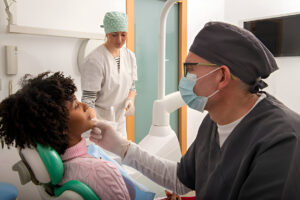As per the Office for Health Improvement and Disparities, around 1 in 5 adults report being diagnosed with gum disease. It is a prevalent issue related to dental pain and damaged teeth. Research shows it’s more common in lower-income or deprived areas.
Early gum disease, such as gingivitis, is treatable with regular dental cleanings and a good oral hygiene routine. However, untreated cases can progress to periodontal disease, which causes irreversible damage.
In this blog post, you’ll learn practical ways to prevent gum disease with personal care and professional medical help.
Gum Disease – Overview
Gum disease is also known as periodontal disease. It is a condition that involves inflammation and infection of the tissues that support your teeth. It commonly happens due to poor oral hygiene. However, some people may suffer from gum disease despite maintaining good brushing and flossing habits.
This dental condition affects the gums and the bone that holds your teeth in place. Gum disease can lead to tooth loss and other serious oral health issues without treatment. Routine dental check-ups and right oral care are important to managing and preventing this condition.
Symptoms of Gum Disease
Do your gums bleed when brushing or flossing? This is one of the first signs of gum disease. Other symptoms include:
- Swollen gums.
- Tender gums.
- Unpleasant taste.
- Chewing pain.
- Changes in how your teeth align or bite together.
- Persistent bad breath.
As the condition worsens, you may notice:
- Receding gums. (Gums pull away from your teeth.)
- Teeth becoming loose or unstable.
Recognizing these signs early can help you treat them early.
Causes of Gum Disease
Gum disease can happen due to various factors. The following are the most common causes of periodontal disease.
- Plaque buildup. It is a sticky layer of bacteria that forms on teeth and gum.
- Tartar formation. It is a hardened plaque (tartar) that irritates gums and promotes gum disease if not professionally removed.
- Failure to brush and floss properly allows plaque and tartar to accumulate.
- Smoking and tobacco use as it weakens gum tissues, reducing the body’s ability to fight infections.
- Pregnancy, menopause, and hormonal changes make gums more prone to inflammation.
- High blood sugar levels impair gum health and healing.
- Some medications reduce saliva, which helps wash away bacteria and protect gums.
- Deficiency of essential nutrients, especially vitamin C can weaken the immune system and gums.
- Chronic stress reduces immunity which makes it harder to fight bacterial infections.
- Excessive force on teeth and gums also causes gum damage.
- Irregular dental visits and cleanings cause tartar to collect and worsen gum conditions.
- Crooked teeth or poorly fitted restorations create hard-to-clean areas where bacteria can thrive.
Knowing these causes is important in preventing gum disease and maintaining improved oral health.
Risk Factors for Gum Disease
Several factors increase your risk of gum disease:
- Smoking or using tobacco.
- Diabetes or autoimmune conditions like lupus.
- Hormonal changes during puberty, pregnancy, or menopause.
- Stress and poor dietary habits.
- Family history of periodontal disease.
Managing these risk factors can lower your chances of developing gum disease.
Stages of Gum Disease
Gingivitis: The Reversible Stage
Gingivitis is the earliest stage of gum disease. It is described as red and puffy gums that may bleed during brushing or flossing. At this stage, there is no bone loss, making it completely reversible with timely dental care.
Periodontitis: Mild to Advanced Stages
As gingivitis progresses, it turns into periodontitis.
- Mild periodontitis causes gum pockets to form, trapping bacteria that toothbrushes and floss cannot reach.
- Moderate periodontitis spoils the soft tissues and bone supporting your teeth.
- In advanced stages, bone loss can lead to loose or lost teeth.
Early intervention is important to prevent irreversible damage.
Gum Disease Prevention Tips
Practice Good Oral Hygiene
Gum disease develops over time. The key to prevention is maintaining ideal oral hygiene. Brush your teeth twice daily with fluoride toothpaste and floss daily to remove plaque between your teeth. Regular dental cleanings every six months help you to remove tartar that brushing alone cannot tackle.
Constant care keeps your gums healthy and prevents other oral health issues. Make oral hygiene a priority from today.
Get More Vitamin C
Did you know a vitamin C deficiency can lead to gum disease? Vitamin C strengthens your immune system and boosts gum healing. Add oranges, kiwis, and strawberries to your diet or take supplements to maintain healthy gums. Regular intake can reduce gum swelling and bleeding.
Eat a Balanced Diet
A nutritious diet benefits not just your overall health but also your gums. Reduce the intake of sugary foods and beverages that create harmful bacteria in your mouth. Instead, add fresh vegetables, lean proteins, and whole grains to your meals.
Reading nutritional labels can help you avoid hidden sugars in packaged foods. Eating a balanced diet supports your teeth and gums, giving you healthier gums over time.
Stay Hydrated
Water is essential for oral health. Saliva is your body’s natural defense against plaque as it washes away food particles and bacteria. Drink lots of water throughout the day to stay hydrated. Don’t have dehydrating drinks like coffee and alcohol because they dry your mouth and reduce saliva production. Staying hydrated is an easy and effective way to protect your gums.
Schedule Regular Teeth Cleanings
Professional dental cleanings are essential for preventing gum disease. Dentists can remove plaque and tartar that are missed when brushing and flossing. During these routine visits, they check for early signs of gum disease. Scaling and root planing treatments can manage the condition if you already have gum disease. Regular check-ups help you to make your gums stay healthy and disease-free.
Diagnosis & Treatment of Gum Disease
Dentists diagnose gum disease during routine exams. They look for plaque buildup, gum recession, and pocket depth around teeth.
X-rays show bone loss, which also helps evaluate the severity of the disease. Early diagnosis helps achieve better outcomes, so don’t skip dental visits.
Treatment Options for Gum Disease
Treatment depends on the severity of the condition and patient’s oral condition:
- Early Stage: Changing your oral hygiene and professional cleanings can reverse gingivitis.
- Mild Periodontitis: Scaling and root planing clear plaque and bacteria from beneath the gums.
- Advanced Periodontitis: Surgical options like pocket reduction or bone grafting repair severe damage.
Some dentists use advanced techniques like laser-assisted new attachment procedures (LANAP) for less invasive treatment. Always discuss treatment options with your dentist to find the best solution.
Conclusion
Gum disease is preventable and manageable with the proper care. You can protect your gums from damage by following good oral hygiene, eating a balanced diet, and scheduling regular dental cleanings. Early detection is essential, so pay attention to the signs and act quickly.
If you’re suffering from bleeding and swollen gums, don’t wait for symptoms to worsen; seek professional care at Moston Dental Practice today. We’ll help you eliminate the infection and restore your teeth and gums to a healthy condition.


